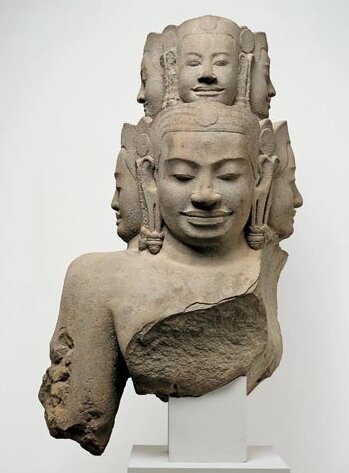Khmer Stone Sculptures: A Collection Seen from a Material Point of View
by Federico Carò
A scientific analysis of the stone sculptures kept at the controversial MET collection of Khmer art.

- Publication
- in Scientific Research in the Metropolitan Museum of Art, ed. Marco Leona, The Metropolitan Museum of Art Bulletin, Volume LXVII, Number 1, New York.
- Published
- 2009
- Author
- Federico Carò
- Pages
- 7
- Language
- English
pdf 637.0 KB
This petrographic study centered on 54 Khmer sculptures kept at the Metropolitan Museum of Art, New York City, USA. Through the centuries, Khmer sculptors and architects mostly used three main types of sandstone: feldspathic arenite, quartz arenite, and graywacke.
According to the author, “feldspathic arenite, which constitutes the main sub horizontal tablelands of the Lower to Middle Jurassic Age in northern Cambodia, seems to have been the preferred material for statuary in the highly centralized Angkor kingdom from the tenth to the sixteenth century. This sandstone forms the shallow bedrock of the region around Koh Ker, some sixty miles northeast of Angkor, which served as the capital of the Khmer empire for a brief time during the reigns of King Jayavarman IV and his son Harshavarman II (928 – 44).”
Feldspathic arenite is a sandstone where feldspar is an important detrital constituent that, together with quartz, makes up about 90% of the rock.This sandstone is characterized by a yellowish gray color and a granular texture.
“The second arenite is classified as quartz arenite, or arenite with more than 75% quartz. This sandstone often exhibits a light reddish or pinkish gray color (caused by the diffuse film of hematite coating the grains and interstices) and a compact, crisp surface appearance (…) Graywacke sandstones are distinguished by their dark grayish to dark greenish color, remarkable compaction, and, in some cases, highly polished finish. The graywackes in the Museum study are compact, fine-grained, and immature sandstones with a variable content of quartz, feldspar, and lithic fragments. They are mostly of two types, which have compositions varying from feldspato-lithic to litho-feldspathic and which differ as to the type and the relative abundance of rock fragments in the framework grains (…) The study reveals that it is possible to group the sculptures according to strong petrographic similarities.”
As for the pre-Angkorean sculptures, the ones kept at the Museum “date from the sixth to the ninth century and represent a diversity of styles and iconographies, yet they were made from similar stone material worked with consummate skill. These early Khmer works originating from the southern provinces of Cambodia are carved from feldspato-lithic to litho-feldspathic graywacke that displays a generally well preserved, dark grayish to dark greenish, sometimes highly polished surface. This sandstone was rarely used for buildings, although a similar type of stone has been found in the early sanctuary of Ta Keo, built in the late tenth to early eleventh century.”
ADB Input: Several pieces considered in this study have been located in Gallery 249 at the MET, with illicit origin involving the illegal activities of collectors Douglas Latchford and Martin Lerner. See a 2022 New York Times report.
Khmer art pieces with contested origins at the MET Gallery 249 in August 2022 (Photo Jeenah Moon for The New York Times).
Photo: Hevajra statue at the MET (MET).
Tags: Khmer arts, sculpture, petrography, museology, MET
About the Author

Federico Carò
Federico Carò is a researcher in archaeology and petrography at the Scientific Department of the Metropolitan Museum of Art (MET), New York City, USA.
In 2017, he published with M. Polkinghorne and J.G. Douglas ¨Carving at the Capital: A stone workshop at Hariharalaya, Angkor¨(Smithsonian Institute).
F. Caro during a research campaign in Cambodia in the years 2010s (photo MET).



